공지사항
-
- '노란봉투'캠페인/국제연대..
- no chr.!
5112개의 게시물을 찾았습니다.
As announced last Friday, yesterday afternoon a small protest rally took place in front of Seoul Station to support the struggle of migrant workers in S.K. against the increasing wave of crackdown terror..
MWTV already produced and published a short documentary about the event and you can watch it here!
Almost at the same time a bunch of reactionary idiots (racists!!) demanded from the LMB administration a "stronger crackdown" on migrant workers in S.K. Just see the following "reports" in the bourgeois media..
..by Yonhap (via today's reactionary daily newspaper JoongAng Ilbo):
Migrant workers, civic group hold dueling rallies
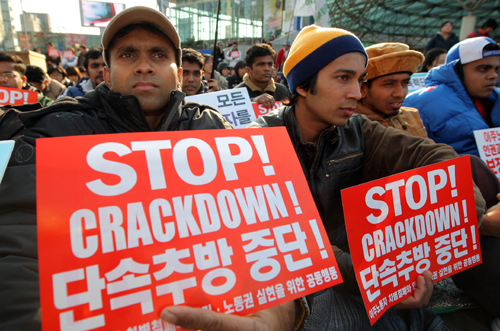
Migrant workers hold posters yesterday denouncing the immigration crackdown on illegal workers and calling for full labor rights at a rally at Seoul Station. Around 300 workers attended the rally.
Meanwhile, a Korean civic group simultaneously held a rally in Daehangno, Seoul, to urge the government to come down harder on illegal workers. The conservative group argued that illegal migrant workers should be deported to protect Koreans’ job security. The two groups denounced each other.
..by Korea Times (11.30):
Searching for a scapegoat?
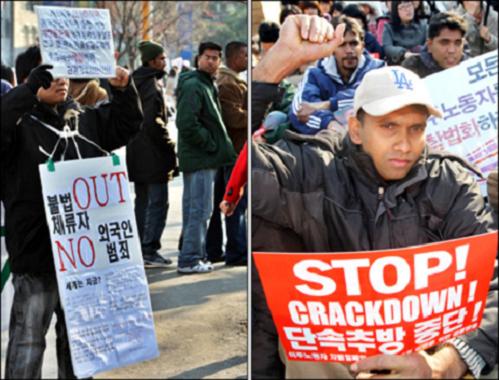
Economic hard times have cornered migrant workers in Korea. With the jobless rate growing, ultra conservatives have begun to chant for ousting foreign workers, who complain about the escalation of a crackdown.
In the left photo, a member of the “Alliance for Coping With Foreign Laborers,” a civic group opposing the employment of migrant workers holds a one-man rally Sunday to call for the deportation of foreign employees overstaying their visas, on the plaza in front of Seoul Station, where migrant workers also rallied to denounce the government’s recent crackdown on illegal foreign workers. In the right photo, foreign workers chant slogans calling for the government to stop cracking down on foreign workers.
From today's Guardian (UK):
Protests over global recession
The governments of Turkey, Hungary and Iceland, three of the countries hit hardest by the global economic downturn, faced mass demonstrations against austerity measures yesterday.
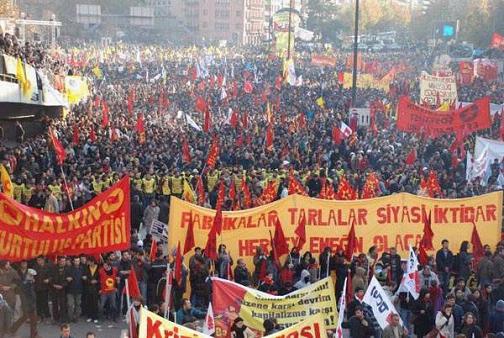
11.29, Ankara (TR): Labour union (DiSK, KESK) demo for:
"Employment, Peace and Democracy - Workers' Unity!"
Thousands of Turkish workers clashed with police in Ankara (*), at a demonstration held by the two biggest unions (DiSK, KESK) to protest against a possible International Monetary Fund deal. The IMF is negotiating with Turkey on a loan to stem the impact of the global financial crisis on the country. Six police officers and several protesters were injured and are being treated in hospital, the state news agency reported.
The rising price of basic commodities such as gas, oil, wheat and rice has hurt consumers and the government is working on a stimulus package to curb rising unemployment, which is hovering at 10 per cent.
In Budapest, thousands of firefighters, teachers and other public employees demonstrated outside Hungary's parliament to protest against austerity measures.
To reduce the state budget deficit, the government plans to temporarily suspend or limit wage bonuses and pensions, among other steps.
Icelanders gathered outside their parliament to demand the resignation of the government they blame for leading their country into an economic abyss. Violence flared as protesters tried to storm a police station to free an arrested demonstrator. At least five people were injured.
http://www.guardian.co.uk/business/2008/nov/30/global-economy-turkey-demonstration
* Here some impressions from the "event" in Ankara, triggered by the repeated attacks of the riot cops against the demonstration:
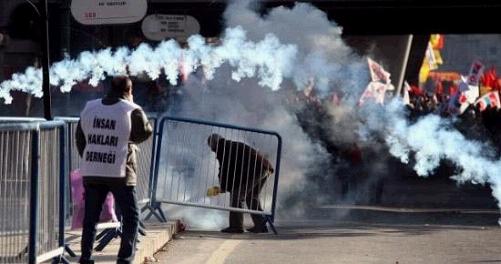
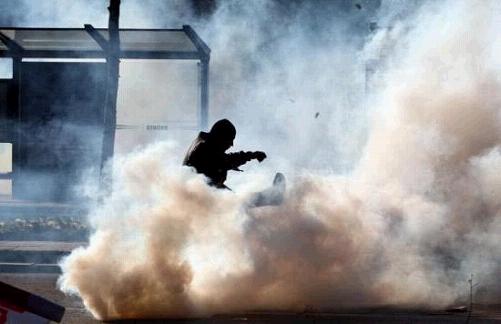
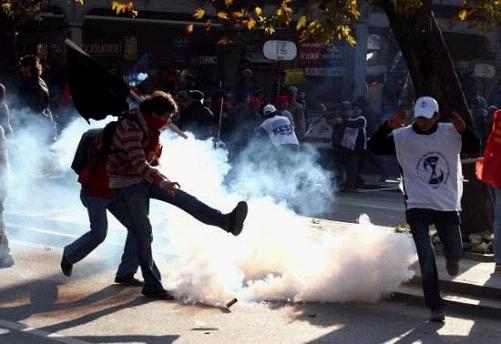
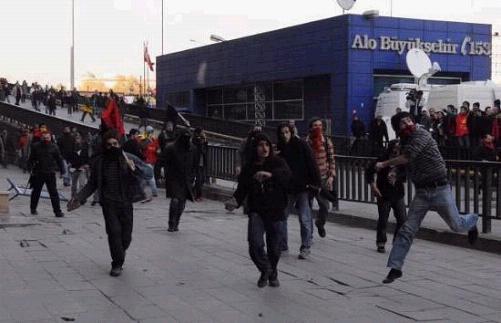
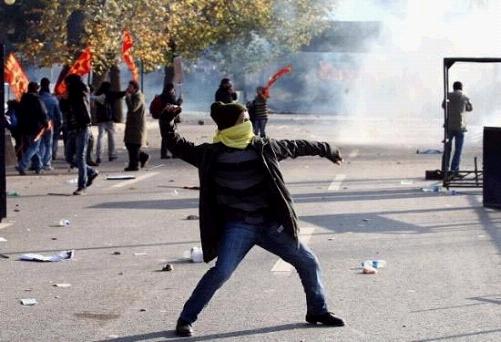

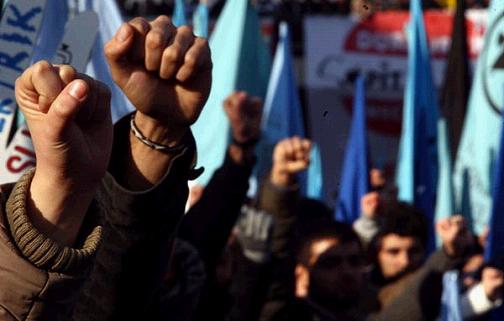
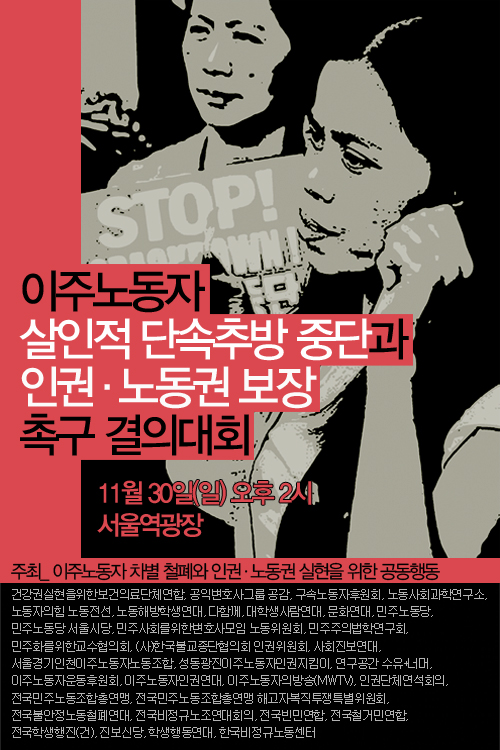
PS:
Almost simultaneously (1 p.m.) a bunch of f****** reactionary idiots (racists!!) will held a rally/march in Daehangno calling for a "stronger crackdown" on migrant workers!!
☞ “불체자 우대하는 세력 때문에 서민층 역차별”
Asia Times (HK) published yesterday following remarkable article, written by A. Lankov:
Pyongyang puts politics above dollars
It appears the dreams of Washington conservatives are likely to be carried through by the force they dislike most - North Korea.
The Korean Central News Agency (KCNA) on Monday announced that from December 1 it would restrict movement across the border with South Korea, suspend an historic railway and "selectively expel" South Koreans based at two joint projects in the North, the Kaesong Industrial Estate and the Mount Kumgang tourist resort. This followed South Korea's "policy of confrontation", KCNA said.
The Kaesong Industrial Park, long a flagship of North-South economic interaction, is a thorn in the side of the more extreme factions of the American right. The decision to place restrictions on it, however, did not come in a way the conservatives hoped for: from a righteous Seoul administration which finally saw the light and decided to cut down the lifeline of the "evil" North Korean dictatorship. The controversial park project is to be closed by North Korea, that is, by the people who benefit most from its activities to the tune of tens of millions of dollars a year.
In letters to business groups, quoted by the South's Unification Ministry, Pyongyang said half the "unnecessary" South Korean staff at the estate must leave. The move will severely disrupt operations at Kaesong, where more than 32,000 North Koreans earning about US$60 a month each work for 83 South Korean-owned factories, along with about 1,500 South Korean managers and technicians.
Trouble has been brewing since mid-October, when North Korea said the South Korean government should stop the activities of South Korean non-governmental organizations (NGOs) which were sending air balloons with leaflets and hard currency to North Korea.
They made it clear that they would retaliate by closing down Kaesong. Pyongyang says the activities of the NGOs are in a breach of a 2002 agreement which explicitly prohibits both Korean governments from waging propaganda battles against one another. When this agreement was signed, the militaries of both sides switched off their loudspeakers at the demilitarized zone between the countries. For decades the sides had bombarded each other with subversive messages (admittedly, without any noticeable effects). The sending of leaflets by balloons, a standard practice before 2002, was stopped as well.
However, NGOs took over where the government stopped. Three major civic groups based in the South conduct leaflet operations. Their messages differ, but they all use the same tactics: using favorable winds, a balloon with a leaflet-packed container is released, with calculations made to ensure it reaches a major population center. Then, when the balloon is supposed to be over its target area, the leaflets are automatically released. The technology was not provided by the South Korean military, so the NGOs had to develop it themselves.
The groups that send leaflets to the North include the North Korean Christian Association (chairman Yi Myong-bok), Fighter for Free North Korea (chairman Pak Sang-hak) and the Union of the Abductees' Families (chairman Choe Song-yong). The groups often cooperate, but their approach and messages are different.
Yi Myong-bok, a defector and a Christian activist, puts special emphasis on the spread of Christianity. Pak Sang-hak, also a defector, believes that democracy should come first, so his group's leaflets reflect this belief.
Finally, Choe Song-yong and his supporters represent families of nearly 500 South Korean citizens, largely fishermen, who have been abducted by the North Koreans since 1953. Among other things, they send leaflets with the lists of the abductees - on the assumption that some of them will learn that they are not forgotten and then find some way to contact their relatives in the South.
No doubt, the leaflets annoy the North Korean rulers a lot, but until recently they tacitly tolerated them. Now things have changed and Pyongyang has acted on its word that it would take action if the balloons did not stop.
The NGOs are independent from the Seoul government and in some cases their relations with the authorities are tense. They are very hostile to the North Korean regime and not particularly fond of the Kaesong project, so they refused to bow to any pressure and continued in a most visible way.
The loss or restriction of Kaesong would be a big blow. It began operations in late 2004 and was designed to make use of cheap North Korean labor. Even though Pyongyang pockets most of the money paid to the North Korean workers, they are still relatively well off in a country in which the average official monthly salary is US$2 a month.
There are no figures indicating the extent to which the South Korean side profits from the undertaking in purely economic terms. The companies in Kaesong are heavily subsidized by Seoul through direct and indirect channels, and the system of these subsidies is not particularly transparent, perhaps deliberately so since the government does not want to tell taxpayers how much money is being spent on aiding the North. One can only assume it is an unprofitable operation for the South Koreans.
Kaesong has been frequently criticized by hawks in Washington, who see it as yet another way to indirectly subsidize the North Korean regime. Indeed, the regime is no doubt making good money out of Kaesong. So why is it prepared to close or restrict it so abruptly?
First, it is difficult to take the official explanation of the balloons at face value. The leaflets they drop are disturbing and annoying, but they hardly constitute a direct threat. After all, Pyongyang was not influenced by the much larger efforts of South Korean propagandists before 2002.
From frequent talks with North Korean defectors, the author has the impression the leaflets have not had much impact on North Koreans. Even if they come across a leaflet and read it (they are supposed to surrender leaflets without reading them), they do not necessarily believe the statements. How can they know that the statements are not wild exaggerations or fabrications, not that much different from the lies they read in their own official newspapers every day?
So, if leaflets are a pretext, the real reason could be the Kaesong project itself, in that it provides opportunities for unauthorized exchanges, given the large numbers of North and South Koreans working together for the first time in 60 years since war divided the peninsula.
The North Koreans not only learn modern technical skills, they also have ample scope to look at their southern compatriots and see that they do not behave like South Koreans are supposed to, according to North Korean propaganda. Cautious political discussions can't be ruled out, which in the long run could have a great impact on the internal situation of North Korea.
This must have been a crucial consideration for Pyongyang, as the survival of the North greatly depends on maintaining the myths about the South, such as it being a starving US colony, a "living hell, land of destitution and despair".
In recent years, the spread of smuggled South Korean videos has made this propaganda line unsustainable. Now, North Koreans are told that the South, while probably affluent, has lost its true national identity, so its inhabitants are full of admiration towards the spiritual purity of their Northern brethren. The southerners, the propaganda claims, also badly want to purify themselves under the wise guidance of the Dear Leader Kim Jong-il (allegedly a cult figure in both the South and the North).
The leaders in Pyongyang do not want this myth exposed, and for North Koreans to see how badly the North fares in comparison to the prosperous and free South - something about which the leaders themselves have no doubts.
In this context, Kaesong was a gamble from the outset, and for a while Pyongyang seemingly decided that since the monetary rewards were good, the political risks could be accepted and managed.
Perhaps they also wanted to check whether they could contain the spread of dangerous information; the decision was made in 2002-2004, when North Korean politics were going through a period of very limited but still unprecedented relaxation.
However, the relaxation soon ended. Since late 2004, North Korean leaders have worked hard to turn back the clock to the situation that existed in the 1970s and 1980s. They reintroduced rationing of food, limited market activities (and now, if very recent rumors are to be believed, are contemplating a near complete closure of markets from January). All recent measures have been about greater control and tougher restrictions.
Unlike optimists overseas, they believe North Korea cannot afford to emulate the success of China in transforming the economy as this would entail a considerable relaxation of domestic police control. China survived such a relaxation, but there is a great difference between North Korea and China. The Chinese leaders do not have to deal with the existence of a "South", "another Korea", a large country in which people speak the same language but enjoy nearly unbelievable prosperity. The North Korean leaders believe their populace will become uncontrollable if the common people learn how prosperous the South really is.
Over the past few years this has made Kaesong something of an anachronism, the only project in the country working towards greater openness and liberalism. Now it seems this anachronism is not going to last, it has become too dangerous; the era of openness is well and truly over. The measure is likely to prolong the agony of North Korea, but it gives the North's leaders additional time to enjoy their moderately luxurious lifestyle.
Hawks in Washington might hope that the decision will deprive the North Korean regime of revenue, thus bringing its end closer. But they are wrong. The regime can survive in isolation - actually, it can survive only in isolation. Starving people do not rebel; they just die, especially when they have no idea that a different way of life is possible.
Kaesong offered a glimmer of light, but now this is being snuffed out, to the peril of the long-suffering people of North Korea.
http://www.atimes.com/atimes/Korea/JK26Dg01.html
Also yesterday the S.K. "left-liberal" daily Hankyoreh had its emphasis on the same issue. But its "analyses" are (surprise, surprise!!) in a sharp contrast to Lankov's opinion:
☞ The five factors have brought inter-Korean relations to the brink
Japan: New poster warns about "illegal" immigrants/migrant workers:
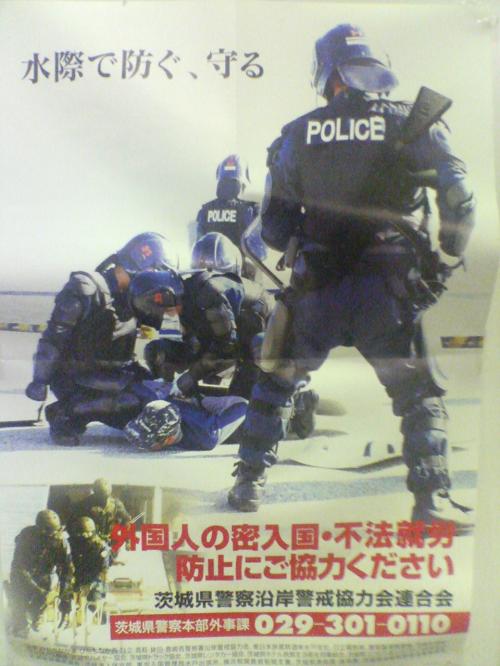
The text on the poster can be translated as:
>STOP THEM AT THE SHORES, PROTECT [OUR COUNTRY].
>PLEASE COOPERATE IN STOPPING ILLEGAL ALIENS AND THEIR ILLEGAL ENTRY.
>CONTACT IBARAKI PREFECTURAL POLICE HQ, 029-301-0110.
The poster is very similar to an earlier poster issued already last year by the Ibaraki police, only this time the officers wearing riot gear now seem to require submachine guns to subdue "illegal immigrants".
The poster, issued last year:
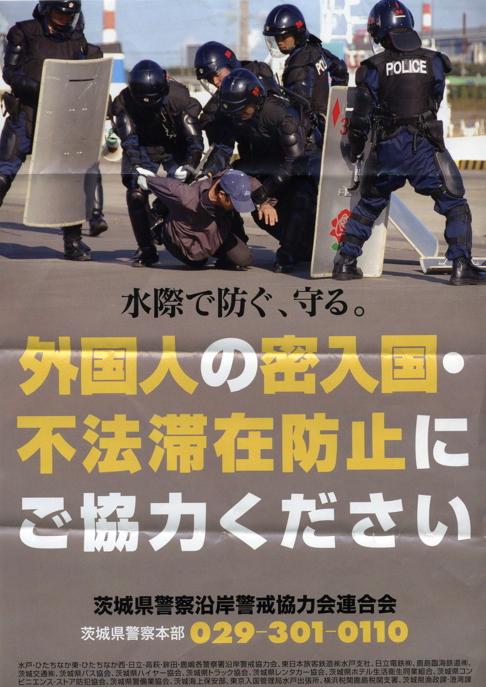
source: DEBITO.ORG
PS:
The S.K. immigration (or better said DEPORTATION!!) "authorities" have a lot more to learn.. from Korea's former colonial power!! (^^)
DailyNK (11.16) claims to have interviewed an “official” from Pyeongyang who discussed recent developments in the Kaesong Industrial Zone:
There Is an Internal Reason for the Bluff(*) on Kaesong
“If North Korea had not experienced the great famine and economic crisis in late 1990s, North Korea would have already started dismantling the Kaesong Industrial Complex,” a North Korean high official stated in an interview with the Daily NK.
The Daily NK met the official from Pyongyang when he visited China on the 13th and talked about the current North Korean hard-line attitude. According to him, regardless of the leaflet issue the Kaesong Complex issue was just dealt with by the internal order...
Daily NK tries to see through to the intent of North Korean authorities on the current pressure over the South via this interview with a North Korean high official.
Q. What is the reason that North Korea is trying to suspend the business in the Kaesong Industrial Complex?
A. In fact, the story about the suspension of the Kaesong Complex has emanated from Pyongyang since this fall, but it had been decided as an instruction of the Party in Pyongyang late last year.
It is hard to say conclusively what is happening in Kaesong, because there are so many complicated things at work. People from the Party in Pyongyang say that the Kaesong Complex and tourism should fall into disuse and the Mt. Geumgang tourism site should be left alone. Whether or not the Kaesong Complex is thrown away is only up to our economy condition and also the General (Kim Jong Il)’s decision.
Q. What do you mean by “complicated things” regarding Kaesong?
A. When Mt. Geumgang tourism was first suggested, there was an idea to unfold Mt. Baikdu and Mt. Koowal and let Geumgang alone.
From late 1996 to early 1997, officials in economic fields suggested a plan to develop the tourist industry in order to earn foreign currency for the Party, but they were strongly criticized for anti-revolutionary actions in encouraging capitalist culture.
At the time, even at general lectures aimed at ordinary residents, the authorities released and stated publicly that the idea to make money through the tourist business came from ignoble motives to attract the corrupted capitalist culture into our society.
Sohn Sung Pil, who was an ambassador to Russia, and many other officials affiliated with the Foreign Trade General Bureau and the Chosun (North Korea) Tourist General Bureau were demoted and disappeared due to this suggestion. However, ironically, a year later, the Mt. Geumgang Tour started in an intensely surprising way. The Kaesong Industrial Complex started in the same manner.
There was much to be said at the beginning of the Kaesong businesses. Some officials insisted that we should have never opened the doors, although we had no choice other than eating only grassroots. The point that the target of the business was the South Chosun was more serious than the opinion that it could have attract the capitalist enterprises.
Therefore, there are many officials in Pyongyang who are skeptical about the Mt. Geumgang tour site and the Kaesong Complex. However, there are also surely some optimistic factions.
Q. Do you mean that instructions on the Kaesong Complex have already been decided internally by the Party?
Yes, you can say that. This was because at the beginning, they started it on in the precondition of switching workers once a year, but now they know that switching workers every year is impossible.
Additionally, rumors on South Chosun have been constantly circulating among workers and their families, so illusion of the South have now become uncontrollable among the people. The authorities cannot overlook this situation.
From the Party’s view, each worker in Mt. Geumgang and Kaesong is like a poster advertising capitalism. Due to them, our socialist system could be cracked.
As I know, at least 20 affiliates with Kaesong Complex came into questioning for advertising South Chosun and capitalism.
There was a thorough reshuffling in the Party last year. There is nobody who talks about Kaesong or Mt. Geumgang.
Q. So, why are they now talking about the suspension of the Kaesong Complex? Is it only to press the Lee Myung Bak administration?
A. Don’t consider it just as threatening words. We are coping with the situation. When the Party wrote the New Year’s Statement of this year, they took an optimistic view regarding the international situation. They thought that everything including the Six Party Talks was under the thumb of Chosun (North Korea), so the U.S. would have followed our actions.
They anticipated that we could have breathed a sigh of relief when the U.S. would have removed Chosun from its terrorism list and lifted the trade sanctions over Chosun in around May or June. Regarding the South’s position, they also believed that as long as relations with the U.S. would have been solved smoothly, South Chosun did not have any choice but to follow the U.S.’ move because Lee Myung Bak was known as a businessman who was able to make practical benefits.
However, in the spring the food situation took a turn for the worse, the U.S. delayed removing Chosun from the list and the Lee administration did not show its good faith to us. Therefore, the story of the suspension of the Kaesong Complex subsequently unfolded.
Q. Can North Korea ignore the abundant dollars from Kaesong in practice?
A. Frankly speaking, we have relied on it due to money. Even right now, if South Korea treats things like the Mt. Geumgang shooting accident flexibly and starts the tours again, everything is okay. The money we want does not need to come only from South Korea. There are Yuan, Rubles and dollars as well. They are all the same.
Although our economy is so terrible, we will not establish the national vision only targeted on making money. You should bear this point in mind.
Q. Is there any other alternatives if the Kaesong closes?
A. On the assumption that the state is optimistic, we have discussed two items regarding the closure of the Kaesong Complex.
First, developing Nampo as a special economic zone and Ra-Sun also as a special city like Hong Kong could be done through linking trains between Kaesong and Nampo and Kaesong and Ra-Sun (Rajin-Sunbong special zone). If transportation, electricity and trains are guaranteed, we don’t need to adamantly defend Kaesong.
In this case, we could lead the South’s enterprises to move into Nampo. There may be some conflicts with the South Chosun administration, but it will go ultimately according to our intention. If the railroad is open, Southern enterprises may flock to Nampo rather than to Rasun.
Second, if the Lee administration tries to degrade relations with us, we plan to concentrate on Rasun. We could operate it with the assistance of Russia and China. If Rasun is thriving, the Southern enterprises will have interests in it and gather there.
Q. This way is unconvincing...
A. There is a rumor that the Vice President of China, Xi Jinping, promised to assist us with “one billion dollars” when he visited Pyongyang in June. We are now trying to receive assistance from Russia. We are not in a proper state yet to talk about Nampo. I don’t think it will be easy to open Nampo.
Q. So then, why does the North Korean Army make something out of the leaflets?
A. That is not a problem I can talk about. However, you surely have also something to gain through the leaflets. If our military does not anything about this issue, they could be hurt by the Party in Pyongyang through some inspections.
The Kaesong Industrial Complex matter is a decisive issue to choose between “money” and “socialism.” If relations with the U.S. had developed well and the economic crisis did not happen this year, we would have already rushed into dismantling the Kaesong Complex.
http://www.dailynk.com/english/read.php?cataId=nk02500&num=4284
* "Bluff"?? Not really!! ..as N.K. proved with its yesterday's announcement:
☞ KPA Notifies S. Korean Puppet Authorities of Crucial Measures..
Although the following article about the GLOBAL FOOD CRISIS isn't the newest, it has been already published seven month ago (4.14) in the German bourgeois magazine Der Spiegel, but the main subject is still up to date. Particularly after last week's news that "Korea’s Daewoo Leases an Area Half of the Size of Belgium in Madagascar for Free" (*), as EcoWorldly headlined last Saturday (**)..
The Fury of the Poor
Around the world, rising food prices have made basic staples like rice and corn unaffordable for many people, pushing the poor to the barricades because they can no longer get enough to eat. But the worst is yet to come.
Fort Dimanche, a former prison in the hills above the Haitian capital Port-au-Prince, is a hell on earth. In the past, it was home to the torture chambers of former dictator "Baby Doc" Duvalier's death squads, the Tontons Macoutes. Today thousands of impoverished Haitians live in the prison's grounds, digging through piles of garbage for food. But even dogs find little to eat there.
On the roof of the former prison, enterprising women prepare something that looks like biscuits and is even called by that name. The key ingredient, yellow clay, is trucked in from the nearby mountains. The clay is combined with salt and vegetable fat to make dough, which is then dried in the sun.
For many Haitians, the mud biscuits are their only food. They taste of fat, suck the moisture out of the mouth and leave behind an aftertaste of dirt. They often cause diarrhea, but they help to numb the pangs of hunger. "I'm hoping one day I'll have enough food to eat, so I can stop eating these," Marie Noël, who survives with her seven children on the dirt cakes, told the Associated Press.
The clay to make 100 of the biscuits costs $5 (€3.15) and has risen by $1.50 (€0.95), or about 40 percent, within one year. The same is true of staple foods. Nevertheless, the same amount of money buys more of the mud cakes than bread or corn tortillas. A daily bowl of rice is almost unaffordable.
The shortages triggered revolts in Haiti last week. A crowd of hungry citizens marched through Port-au-Prince, throwing stones and bottles and chanting, "We are hungry!" in front of the presidential palace. Tires were burned, and people died. It was yet another of the rebellions that are beginning to occur with increasing frequency worldwide, but which are still only a harbinger of what is yet to come.
Food is become increasingly scarce and expensive, and it is already unaffordable for many people. The world's 200 wealthiest people have as much money as about 40 percent of the global population, and yet 850 million people have to go to bed hungry every night. This calamity is "one of the worst violations of human dignity," says former UN Secretary-General Kofi Annan.
Should we be surprised that despair often turns into violence? The food crisis afflicts the world's poor -- in Africa, South Asia and the Middle East -- like a biblical plague. Prices for staples like rice, corn and wheat, which were relatively stable for years, have skyrocketed by over 180 percent in the last three years. A bottleneck is developing whose consequences are potentially more severe than the global crisis in the financial markets. With nothing left to lose, people on the brink of starvation are more likely to react with boundless fury.
The World Bank and the International Monetary Fund (IMF) addressed this global crisis at a joint meeting last weekend. World Bank President Robert Zoellick warned that exploding food prices threaten to cause instability in at least 33 countries, including regional powers like Egypt, Indonesia and Pakistan, where the army has had to be brought in to protect flour transports. The crisis is helping radical Islamic movements gain strength in North Africa. There has been unrest in recent weeks in Mauritania, Mozambique, Senegal, the Ivory Coast and Cameroon, where the violence has already claimed about 100 lives.
There are several reasons for the food crisis:
The world population is growing constantly, while the amount of arable land is declining.
Climate change is causing a loss of agricultural land, irreversible in some cases, as a result of droughts, floods, storms and erosion.
Because of changing eating habits, more and more arable land and virgin forests are being turned into pasture for livestock. The yield per acre in calories of land given over to pasture is substantially lower than that of arable land.
The World Bank wants developing countries to introduce market reforms, including the abolition of protective tariffs, a move that often causes massive damage to local agriculture.
Speculators are driving up the prices of raw materials. The resulting high oil price leads to "energy crops" being cultivated instead of grain for food or animal feed.
Millions of people displaced by civil wars need food, and yet they themselves are no longer capable of producing food.
What we are beginning to face is not just an acute bottleneck, but a worldwide, fundamental food crisis. It affects most of all the poor, who spend a disproportionately large share of their income on food and water. The crisis is so dire that it is obliterating any progress made in recent years in fighting disease and starvation.
With too many people and not enough agricultural land, a struggle for the distribution of the best farmland is taking shape that could turn into a new North-South conflict. "These days you hear a lot about the world financial crisis," wrote US economist Paul Krugman recently in his regular column in the New York Times. "But there’s another world crisis under way -- and it’s hurting a lot more people."
Mexicans were the first to take to the streets, when they protested against higher prices for cornmeal, the basic ingredient in tortillas. Mexico can only cover a portion of its demand with domestic production. It imports the rest, mainly from the United States. Meanwhile, more and more farmers in the US are selling their corn to biofuel producers, who pay a higher price for the grain.
To avert further protests, Mexican President Felipe Calderón decided to increase government subsidies for corn, which were already high to begin with. But only countries that are relatively strong financially can afford this. In other countries, like Haiti, Bolivia, Algeria and Yemen, the lower classes have been hard hit by food-price inflation.
'People Are Dying Before Our Eyes'
In the Middle Eastern country of Yemen, people get by on an average of €1.18 ($1.86) per day. The government faces the challenges of a wave of refugees from Somalia, tribal warfare in the north and the constant threat of terrorism. Since February, wheat prices in Yemen have doubled and the price of rice and cooking oil has increased by a fifth. And since the end of March, people have died in Yemen in unrest over bread prices.
Within the last quarter, food prices have increased by 145 percent in Lebanon and 20 percent in Syria. "Even parsley, for which we paid almost nothing in the past, has suddenly tripled in price," complains one resident of the Syrian capital Damascus.
Iraq and Sudan, once the "bread baskets" of the Arab world, are nowadays dependent on the World Food Programme. More than a million people in Iraq and 2 million in Sudan's Darfur region require food aid. Life in Darfur, Sudan's western province, has always been difficult. The Sahara has shifted southward in the last four decades, while rainfall has declined dramatically. Yields of sorghum, the area's most important grain crop, have dropped by two-thirds.
The civil war in Sudan has made more than 2 million people in refugee camps completely dependent on food aid. Fields in the region have not been farmed for years. "People are dying before our eyes, while the world looks on," says Johan van der Kamp of the German aid organization Deutsche Welthungerhilfe.
Developing countries faced a similar challenge more than a generation ago, which led to the advent of the so-called Green Revolution. Through the use of fertilizer, pesticides and hybrid seed, farmers in developing countries were able to boost their harvests considerably. Some now believe that it is time to launch a second green revolution. The heads of research at agricultural conglomerates are convinced that genetic engineering could be the answer to the world's food problems. But the question is: how long would it take?
Food shortages have even become an important issue in affluent areas, like Dubai, where supermarkets have pledged not to raise the prices of 20 staple foods for at least one year. The goal, clearly, is to prevent dissatisfaction within the city's legions of Indian and Pakistani construction workers. Without them, the enormous hotels, museums and artificial islands with which Dubai is making such a stir in the world would not exist. Foreign workers are paid their meager wages in the local currency, the dirham, which is tied to the falling dollar.
The beneficiaries of globalization on the Gulf can ill afford food riots in the shadow of their skyscrapers and shopping malls. "The consequences of discontent, anger in the Middle East can be more geo-political than they may be elsewhere," Robin Lodge of the United Nations World Food Programme recently told the news agency Reuters. Nowhere is this truer than in Egypt.
Saad Ibrahim owns a small snack shop in Cairo in a neighborhood behind the Al-Azhar Mosque. He sells dishes like noodles and chickpeas in tomato sauce, and his shop is in a good location. Nevertheless, most of the faithful now walk quickly past his shop after Friday prayers. "I have fewer customers every day," says Ibrahim.
Last fall a ton of noodles cost about 1,500 Egyptian pounds, or a little more than €175 ($276). Since then, prices have tripled. Ibrahim blames the government for the price hike. "As an agricultural country," he says, "we could grow everything ourselves, instead of importing it for a lot of money."
Thirty-two million of Egypt's population of 80 million get by on €1 ($1.58) a day, and 16 million on even less. The price of cooking oil alone has risen by 40 percent within the last year. Inflation jumped to above 12 percent in February, and the higher cost of wheat has had an especially adverse impact.
"Aish baladi," a soft, round flatbread, is a mainstay of the Egyptian diet. The state has subsidized it for decades, which has helped to preserve calm. But for how much longer can this system function? The lines are getting longer in front of bakeries that sell the subsidized bread, as more and more Egyptians depend on government aid. Riots in recent weeks claimed at least 11 lives after corrupt bakers sold inexpensive, subsidized flour at high prices on the black market, triggering an angry response from the public.
Meanwhile, the government has slated $2.5 billion (€1.58 billion) of its new budget for bread subsidies. But providing cheap bread comes with its own bizarre consequences. Some farmers are already feeding bread to their livestock because of the exorbitant cost of animal feed. Raising cattle is a profitable business because rising incomes in some developing countries mean that more and more consumers can afford to eat meat. The new middle class in Delhi and Beijing is no longer satisfied with traditional diets high in foods like rice and lentils. But it takes seven kilograms of feed and vast quantities of water to produce only one kilogram of beef, which only drives up prices.
In Jordan, which has a modern system of agriculture, the cost of staple foods has increased by 60 percent within a year. "I can hardly sell my vegetables anymore," says Hussein Bureidi, a vendor who operates a stand near the Grand Mosque in the Jordanian capital Amman. "How can this go on?" King Abdullah fears a return of the 1996 food riots, when angry citizens clashed with police in the city of Karak.
In Algeria, the prices of cooking fat, corn oil, sugar and flour have doubled within six months. With the exception of an inadequate, 15-percent increase in salaries for civil servants, the government has done little to fend off what Radio Algiers called an "attack on our standard of living." Until now, oil and gas revenues have not been used to fund additional food subsidies. If this were the case, the government might find itself no longer able to service its foreign debt on time.
But India has the largest number of underfed people, about 220 million. Aptly enough, two international conferences on the food crisis took place in New Delhi last week. Jacques Diouf, the Senegalese head of the UN Food and Agriculture Organization (FAO), blamed the dilemma on rapid growth in demand in both China and India. The crisis, Diouf said, could expand into an unprecedented catastrophe.
China has close to a quarter of the world's population to feed, but only 7 percent of its farmland. A similar situation applies in India. This means that both countries must import food on a large scale, prompting many exporting countries to impose export quotas so that their own citizens are not suddenly forced to go without.
When Haiti's hungry poor went on a rampage last week, the United States closed its embassy there as a precaution. The incidents were also sufficiently alarming to British Prime Gordon Brown, who wrote a letter to his Japanese counterpart, Yasuo Fukuda, the current chairman of the G-8 nations. In the letter, Brown recommended that the international community endeavor to prepare a "fully coordinated response" to rampant hunger.
It would not come a moment too soon.
http://www.spiegel.de/international/world/0,1518,547198,00.html
* About 1.3 million hectares, i.e. half of the arable land in Madagascar..
** Here you'll get some more informations about it:
☞ Daewoo to Buy Madagascar (Marmot's Hole, 11.20)
☞ Deal brings many jobs, but at what price? (Guardian, 11.22)
Related:
☞ Across globe, hunger brings rising anger (IHT, 4.18)
Since almost ten days solidarity groups and MTU activists in the south of Gyeonggi-do(Province) are touring around with a solidarity campaign to support the struggle of migrant workers in the region - like here last week in Pyeongtaek:

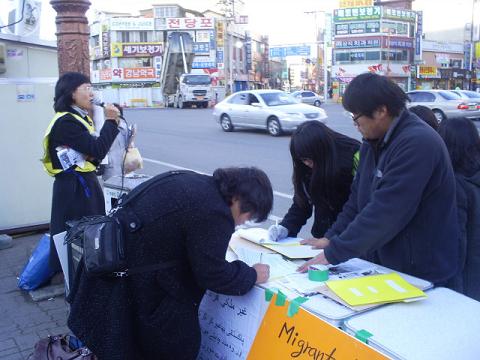
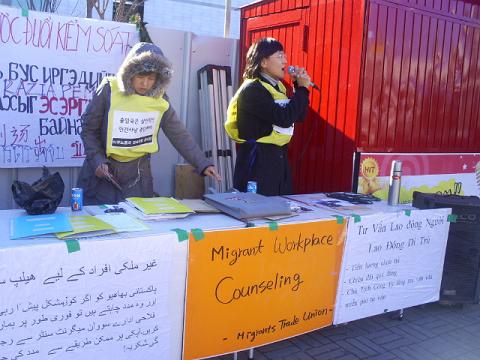
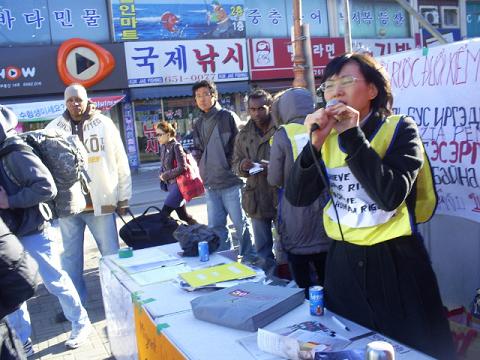
지난주 오산역에 이어 두번째 감시단사업을 진행하였습니다.
평택역앞에서 선전전과 서명전, 상담사업을 진행하였구요, 송탄공단등을 돌며 현장감시단사업도 하면서 이주노동자들을 대상으로 선전전도 하였습니다.
다음주는 안산에서 감시단사업을 진행합니다.
Today's top story in the int'l media:
The report "Global Trends 2025" by the National Intelligence Council (NIC).
Following you can read The Guardian's (UK) article about it:
2025: the end of US dominance
• US intelligence: 'We can no longer call shots alone'
• European Union will be 'hobbled giant' by 2025
• Triumph of western democracy not certain
The United States' leading intelligence organisation has warned that the world is entering an increasingly unstable and unpredictable period in which the advance of western-style democracy is no longer assured, and some states are in danger of being "taken over and run by criminal networks".
The global trends review, produced by the National Intelligence Council (NIC) every four years, represents sobering reading in Barack Obama's intray as he prepares to take office in January. The country he inherits, the report warns, will no longer be able to "call the shots" alone, as its power over an increasingly multipolar world begins to wane.
Looking ahead to 2025, the NIC (which coordinates analysis from all the US intelligence agencies), foresees a fragmented world, where conflict over scarce resources is on the rise, poorly contained by "ramshackle" international institutions, while nuclear proliferation, particularly in the Middle East, and even nuclear conflict grow more likely.
"Global Trends 2025: A World Transformed" warns that the spread of western democratic capitalism cannot be taken for granted, as it was by George Bush and America's neoconservatives.
"No single outcome seems preordained: the Western model of economic liberalism, democracy and secularism, for example, which many assumed to be inevitable, may lose its lustre – at least in the medium term," the report warns.
It adds: "Today wealth is moving not just from West to East but is concentrating more under state control," giving the examples of China and Russia.
"In the wake of the 2008 global financial crisis, the state's role in the economy may be gaining more appeal throughout the world."
At the same time, the US will become "less dominant" in the world – no longer the unrivalled superpower it has been since the end of the Cold War, but a "first among equals" in a more fluid and evenly balanced world, making the unilateralism of the Bush era no longer tenable.
The report predicts that over the next two decades "the multiplicity of influential actors and distrust of vast power means less room for the US to call the shots without the support of strong partnerships."
It is a conclusion that meshes with president elect Obama's stated preference for multilateralism, but the NIC findings suggest that as the years go by it could be harder for Washington to put together "coalitions of the willing" to pursue its agenda.
International organisations, like the UN, seem ill-prepared to fill the vacuum left by receding American power, at a time of multiple potential crises driven by climate change the increasing scarcity of resources like oil, food and water. Those institutions "appear incapable of rising to the challenges without concerted efforts from their leaders" it says.
In an unusually graphic illustration of a possible future, the report presents an imaginary "presidential diary entry" from October 1, 2020, that recounts a devastating hurricane, fuelled by global warming, hitting New York in the middle of the UN's annual general assembly.
"I guess we had it coming, but it was a rude shock," the unnamed president writes. "Some of the scenes were like the stuff from the World War II newsreels, only this time it was not Europe but Manhattan. Those images of the US aircraft carriers and transport ships evacuating thousands in the wake of the flooding still stick in my mind."
As he flies off for an improvised UN reception on board an aircraft carrier, the imaginary future president admits: "The cumulation of disasters, permafrost melting, lower agricultural yields, growing health problems, and the like are taking a terrible toll, much greater than we anticipated 20 years ago."
The last time the NIC published its quadrennial glimpse into the future was December 2004. President Bush had just been re-elected and was preparing his triumphal second inauguration that was to mark the high-water mark for neoconservatism. That report matched the mood of the times.
It was called Mapping the Global Future, and looked forward as far as 2020 when it projected "continued US dominance, positing that most major powers have forsaken the idea of balancing the US".
That confidence is entirely lacking from this far more sober assessment. Also gone is the belief that oil and gas supplies "in the ground" were "sufficient to meet global demand". The new report views a transition to cleaner fuels as inevitable. It is just the speed that is in question.
The NIC believes it is most likely that technology will lag behind the depletion of oil and gas reserves. A sudden transition, however, will bring problems of its own, creating instability in the Gulf and Russia.
While emerging economies like China, India and Brazil are likely to grow in influence at America's expense, the same cannot be said of the European Union. The NIC appears relatively certain the EU will be "losing clout" by 2025. Internal bickering and a "democracy gap" separating Brussels from European voters will leave the EU "a hobbled giant", unable to translate its economic clout into global influence.
http://www.guardian.co.uk/world/2008/nov/20/barack-obama-president-intelligence-agency
Here you can read the complete NIC Report (pdf):
☞ GLOBAL TRENDS 2025: A Transformed World
Well, the report "predicts" also something about the "relationship" between N. and S. Korea in 2025..
Today's Korea Herald wrote about it following:
U.S. report sees Korea unification by 2025
South and North Korea could be reunified by 2025 in a form of loose confederation, a latest U.S. intelligence report said.
"We see a unified Korea as likely by 2025 -- if not as a unitary state, then in some form of North-South confederation," the U.S. National Intelligence Council said in a report anticipating the global landscape around year 2025.
The NIC, however, forecasted that a denuclearization of North Korea will remain uncertain even at the time of reunification.
"While diplomacy working to end North Korea's nuclear weapons program continues, the final disposition of the North's nuclear infrastructure and capabilities at the time of reunification remains uncertain," it said. "A loosely confederated Korea might complicate denuclearization efforts."
The 120-page report titled "Global Trends 2025: A Transformed World," was released Thursday.
The Korean unification would entail new challenges such as denuclearization, demilitarization, refugee flows and financing reconstruction. The challenges will raise possibilities for new levels of major power cooperation in managing them, it added...
The asia sentinel (HK) published last month (10.31) following interesting (while the subject is really bizarre, ludicrous...^^) article:
North Korea in the Slow Lane
Cult leader Sun Myung Moon helps Kim Jong-Il build Fiat knockoffs for which there are no drivers
Since 2004, Pyongyang has started to boast billboards — not pictures of the smiling Dear Leader or Great Leader exhorting increases in production, but actual advertisements for actual products — an actual single product, rather.
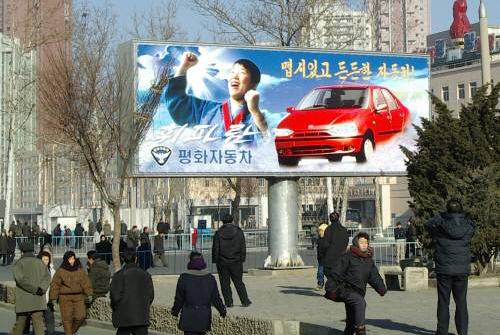
Pyeonghwa Motors' billboard near Pyeongyang (railway) Stn.
Scattered around the city of almost 3 million people, the billboards all promote the same company: Pyeonghwa (Peace) Motors, North Korea's only passenger car manufacturer. A joint venture started in 2002 between the Reverend Sun Myung Moon's Unification Church and North Korea's Ryongbong Corporation, the factory produces a tiny amount of cars for a tiny domestic market.
Does it make economic sense to build or invest in a car factory for a country with 23 million people but fewer than 30,000 vehicles, a city where cars are so scarce that in the warmer months, traffic ladies swinging their stop signs act in place of electric lights, where hardly anybody knows how to drive? And why is Sun Myung Moon, church leader, owner of an international business empire and a virulent anti-communist, investing in North Korea?
Pyeonghwa Motors invested around US$55 million to build the factory on a onetime rice paddy near the port city of Nampo, about 50 kilometers southwest of Pyongyang. In 2003, the JoongAng Daily quoted an executive from the Seoul-based Pyeonghwa, saying he expected the factory, with capacity to build 20,000 cars a year, to eventually turn a profit. However, a spokesman based in Seoul says Pyeonghwa has produced only 2,000 cars and pickup trucks in their first five years of operation.
How many cars have they actually sold? For North Korea, any statistics, much less accurate ones, are "very difficult to come by," said Erik van Ingen Schenau, an Asian car analyst and author of the book "Automobiles Made in North Korea." He quotes a French newspaper article that claims the factory sold around 400 vehicles, including SUVs, pickups, and sedans, in 2006. He estimates the factory sold anyone from 400 to 1000 cars in 2007 and 2008, including the cars they exported to Mekong Auto, a Vietnam-based Moon company, and including the vehicles that they produced with the Shenyang-based China Brilliance.
The Pyeonghwa factory produces cars with names such as Whistle, Cuckoo, and Three Thousand Li, which refers to the national territory of Korea, both North and South peppering the empty streets of Pyongyang, "You see these cars a lot, especially the Cuckoo," said Simon Cockerell, general manager of Koryo Tours, one of the few western tour companies licensed to operate in North Korea.
"It took drivers some getting used to because they were used to driving Japanese cars, with steering wheels on the right," Cockerell said. Japanese cars used to be the most common until the beginning of 2007, when Kim Jong Il banned them from the road. Reasons vary. One report has it that a wrecked Japanese car blocked the way of his convoy as he was leaving his father's mausoleum. Others believe it was in reaction to Japan's increasing pressure over such issues as the North's refusal to tell the Japanese what happened to their kidnapped citizens, or over the North's nuclear bellicosity. While this order only applies to non-government and non-company cars built before 2003, it certainly has not made getting around Pyongang any easier for the tiny majority of residents who travel by car.
Like most items produced in North Korea, the Pyeonghwa vehicles are not known for their quality. "They are probably nearly all hand-assembled, and based on a model from a factory in China that does not have a good reputation," van Ingen Schenau said. "They make cars that no one is interested in and that they cannot export to Japan or South Korea. Maybe it is a prestige item to have a car factory in the country, but it does not seem to have worked out at the moment."
The Whistle, based on the Fiat Siena, is one of the Pyeonghwa vehicles featured on billboards. It sits on a field next to a superimposed image of the Pyongyang Arch of Triumph. Built to commemorate Kim Il Sung and the Korean nation's resistance to the Japanese occupation, the arch stands 60 meters tall, more than 10 meters taller than its model, the Arc de Triomphe in Paris. A boy stands next to the car one hand holding a trophy, while waving a hand, a smile on his face and a medal around his neck. The billboard reads: "Whistle. A Strong and Beautiful Automobile."
It is important to remember the target audience of the billboard. It is not only for the few thousand European tourists who visit the country for six days at a time, or the few hundred businessmen and embassy staff who live in one of the few foreigner hotels isolated from the city. The billboards also exist for the residents of Pyongyang, to show them that their country, despite the harm ostensibly done to it by the entire capitalist world, is still able to go its own way and produce a strong and handsome car.
And while there are many ways the money could be better spent in a starving county, at least capital is flowing into the country and producing a product that might be economically viable in the future.
One has to cobble together what one can to make conclusions about a country so inscrutable that analysts seize upon any little symbol can find they find in the hopes of discovering something new. Residents, the main source of information for news elsewhere in the world, can barely speak to the media at all without getting into trouble, and when they do they have to stick with the party orthodoxy. Foreign businessmen in Pyongyang are quite reticent, understandable for people living in what may be the most paranoid place in the world.
Still, it helps to remember that in general, whether ardent communist or virulent anti-communist, people like to make money. In 1980, Reverend Moon founded CAUSA International, which called for a "worldwide ideological offensive to counter the global threat of communism," and preached for years on the evil of the Marxist systems. In 1991 the North Korea-born Moon met with Kim Il Sung, head of the regime that tortured him in 1948, and gifted him with millions of dollars. Now Moon's company owns the Potonggang Hotel, considered the best in Pyongyang, and the only place in the country where visitors can watch CNN.
North Korea will not remain a backwards communist state that produces handmade cars forever. While its annual per capita income is US$1,700, the same as the Ivory Coast, it is in a key geographical location with billions of dollars of investment waiting to be poured in from China, South Korea, and Japan. And as it keeps opening up, there will be profits to make, profits enough, one hopes, to trump ideology.
http://www.asiasentinel.com/index.php?option=com_content&task=view&id=1513&Itemid=179
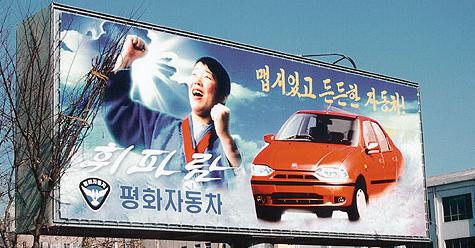
Related stuff from Wikipedia:
☞ Unification Church/Sun Myung Moon
최근 덧글 목록